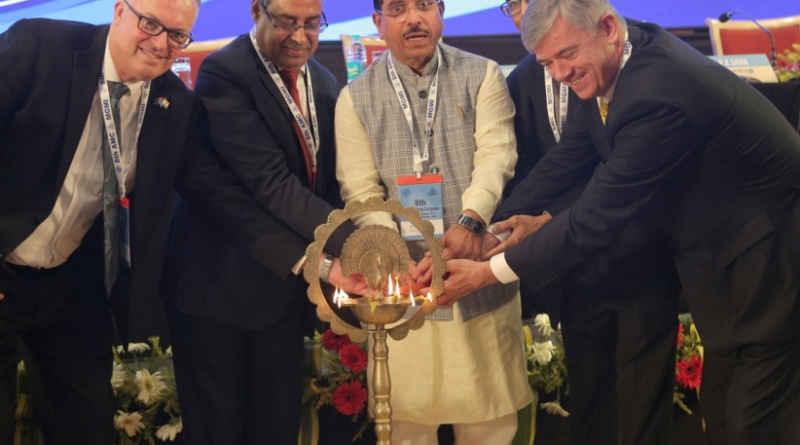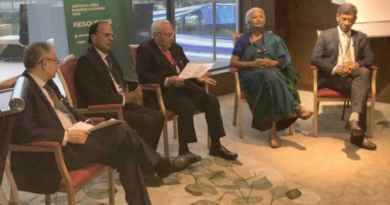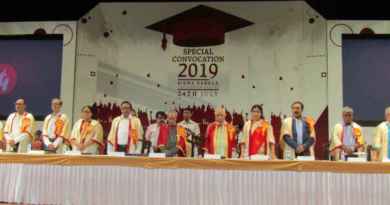Union minister Prahlad Joshi inaugurated 8th Asian Mining Congress and International Mining Exhibition, in Kolkata
Ambar Bhattacharya, abptakmaa, Kolkata, 8th Nov 2019 : The Mining, Geological and Metallurgical Institute of India (MGMI), established way back on 16th January 1906, is a national professional body and is one of the oldest institutes of this kind in the world. The first Asian Mining Congress (AMC) and International Mining, Equipment, Minerals and Metal Exhibition (IME) were held in January 2006 to commemorate the centenary of MGMI. The 2nd AMC and IME were held in January 2008, the 3rd in January 2010, the 4th in January 2012, the 5th in February 2014, the 6th in February 2016 and the 7th in November 2017.

There were very good responses worldwide in those seven events with participation of around 600 delegates from India and abroad. Useful contributions were made by the experts from Asian countries such as Bangladesh, China, Indonesia, Iran, Mongolia, Oman, Nepal, Pakistan, Russia, Thailand, Turkey etc. as well as from the Indian Mineral Industries. The conference proceedings were further enriched by valuable contributions of eminent professionals from Australia, Canada, France, Germany, Poland, South Africa, Sweden, U. K. and U.S.A. This year, for the 8th AMC, we have already received as many as 73 Technical Papers on various topics related to mining and allied subjects from experts in the fields and 14 Keynote addresses from the eminent personalities. These Technical Papers will be presented in the Technical Sessions by the respective Authors before the participants.

The 8th Asian Mining Congress (Theme: Green Mining: The Way Forward…), in this sequel, will be held from 6-8 November 2019 at the hotel, THE WESTIN KOLKATA RAJARHAT, KOLKATA, India.

The Congress aims at global participation of Practising Engineers, Geologists, Managers, Planners, Policy Makers, Equipment Manufacturers, Regulators, Scientists, Academicians and other Mining Professionals to deliberate on various issues related to the Mining, Minerals, Metals and Allied Industries. Deliberations in the Congress will provide much needed pragmatic road map for the growth of the Mining and the Mineral-based industries. The event will be a unique platform for Entrepreneurs, Decision makers, Senior Government Officials, Investors, Industry leaders, Equipment suppliers, Miners, Engineers and Delegates. This important and prestigious event has always served as an ideal platform for Delegates, Decision makers from the Government, Mineral, Mining, Geological and Allied industries.
The Union Minister of Coal Prahlad Joshi said in his welcome speech, I am very happy to be amongst you all today to inaugurate the 8th Asian Mining Congress and International Mining Exhibition, which are being concurrently organised by the Mining, Geological and Metallurgical Institute of India (MGMI), one of the oldest and prestigious professional institutes of this kind in the world, devoted to promote and advance the Mining and Mineral Industries since its inception in 1906. I congratulate the organisers for selecting the theme- Green Mining: The Way Forward, it is definitely apt and timely. In today’s fast pace of technological advancement, energy and environment are major concerns not only for developing countries but also equally for under-developed and developed countries. I would first like to draw your attention towards the National Mineral Policy, 2019 of this country approved by the Union Cabinet, chaired by our Hon’ble Prime Minister Sri Narendra Modi ji. The New National Mineral Policy ensures more effective regulation. It will lead to sustainable mining sector development in future while addressing the issues of project affected persons especially those residing in tribal areas. Many of you may be aware that India is the 3rd largest producer of coal. Coal production in the country stood at 688.8 million tonnes in FY18. India ranks 4th in terms of iron ore production globally. In FY18, production of iron ore stood at 210 million tonnes. India has around 8 per cent of world’s deposits of iron ore. India became the world second largest crude steel producer in 2018 with output 106.5 million tonnes. India has the 7th largest bauxite reserves- around 2,908.85 million tonnes in FY17. Aluminium production stood at 1.33 million metric tonnes during Apr-Aug 2018 and is forecasted to grow to 3.33 million tonnes in FY20. Global trends show that, in foreseeable future, coal will remain the predominant energy source for most of the countries, including India. At the same time, sincere efforts are being made to develop cutting edge technologies for more efficient exploitation of hydroelectric, nuclear, solar, wind and other renewable sources as they are low carbon alternatives. The mining and mineral sectors play pivotal role as supply of indigenous fuel and raw material are two essential ingredients for seamless growth of India. India as a responsible nation is committed to global sustainability objectives put forth by the United Nations and has shown leadership for the Paris Agreement and International Solar Alliance. At the same time, coal is the backbone of India’s energy security and contributes to nearly 60% electricity generation. Growth in coal production and utilizations is anticipated to grow 2-3 times in the next couple of decades. Accordingly, the mining industry has to rise to the challenge of improved coal production in ways that produce minimum possible environmental impact. Heightened coal production is needed to reach the “affordable electricity for all” message of the Hon’ble Prime Minister of India. Even for broader economic security, the location-specificity, intermittency and low-load factors of renewable plants mean existence of coal will continue in the near-future. The versatility of coal also ensures that continued extraction is necessary for industrial development (e.g. in steel) even aside from the power sector. For this purpose, our coal production should reach one billion tonne by 2024 to maintain smooth energy supply. It is also essential that our non-coal mineral sector should further gear up to minimise the demand –supply gap of raw materials. Today, it is a major challenge to maintain our projected growth and development without compromising with our commitments to combat global warming. In order to grow in a sustainable manner, addressing environmental issues appears to be essential. As India’s energy sector and other industries are getting bigger; deforestation, dramatic weakening of water resources, deteriorating air pollution levels and generation of plastic and other wastes are most serious environmental issues in India and abroad. In this connection, I would like to draw the attention of this august gathering towards our commitments in the Paris Agreement which came into force on 4th October 2016 to protect this planet from ill effects of global warming and climate change. I, therefore, would request all of you to deliberate and identify the efficient Green Mining initiatives that can be adopted not only by India but also by rest of the world. While planning for automation it is necessary to identify the potential areas where human resources can be effectively utilised. It is also important for those who are producers and consumers of conventional energy to evolve more efficient and cleaner processes to ensure environment friendly utilisation of natural resources. Finally, I expect that after the three days’ deliberations it will be possible for this learned gathering to come out with practical and doable recommendations which can be implemented to make mining and mineral industries more productive and at the same time eco-friendly. It should be our concerted effort to make this planet not only more industrially advanced but also environmentally conducive for our future generations. I wish 8th Asian Mining Congress and International Mining Exhibition a grand success.




